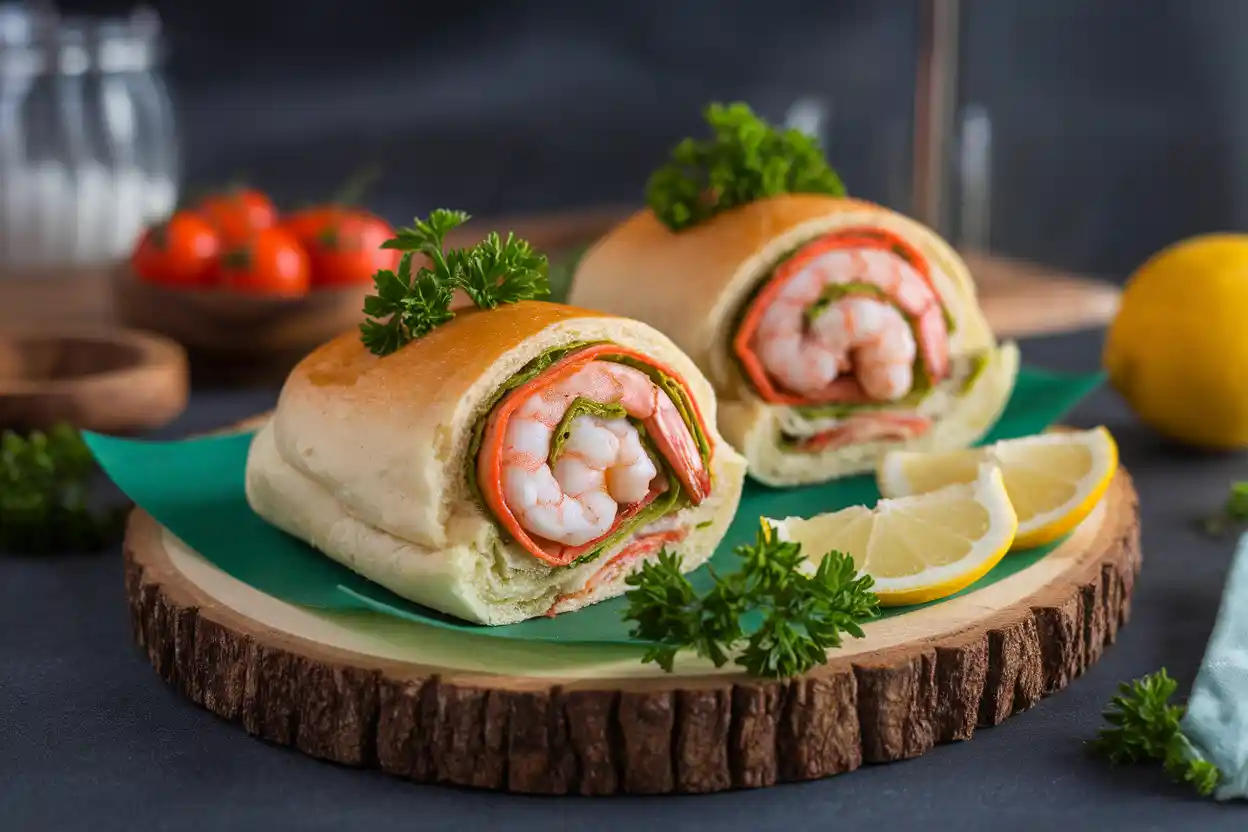Introduction
Shrimp rolls are a beloved dish that bridges the gap between simplicity and gourmet delight. Whether served as a handheld snack or a star player at dinner parties, they combine the tenderness of shrimp with the satisfying crunch or softness of a wrapper. However, many home cooks wonder how to wrap a shrimp roll? The good news is that with a little guidance, wrapping a shrimp roll can be as fun as it is delicious. In this article, we’ll explore everything from understanding shrimp rolls to step-by-step instructions and tips for perfection.
Understanding Shrimp Rolls
What Is a Shrimp Roll?
At its core, a shrimp roll is a versatile dish that typically combines shrimp with a variety of ingredients, wrapped in a bread bun, rice paper, or even lettuce. While the classic shrimp roll is often associated with buttery buns and creamy fillings, variations exist worldwide, each offering its unique spin on flavor and presentation.
From New England’s buttery bun-style shrimp rolls to Asian-inspired versions wrapped in rice paper, this dish adapts to cultures and preferences with ease. No matter the style, the shrimp remains the star, celebrated for its tender, juicy texture and delicate flavor.
Varieties of Shrimp Rolls Across Different Cuisines
Shrimp rolls come in many forms, reflecting the diversity of global cuisines. The Western-style shrimp roll, for instance, emphasizes richness with mayonnaise-based dressings and soft bread buns. On the other hand, Asian-style shrimp rolls often feature fresh vegetables, rice paper wrappers, and dipping sauces like hoisin or peanut sauce for added zest.
Understanding these variations can help you choose the perfect wrapping style for your taste and occasion. Whether you prefer a hearty bun or a refreshing rice paper roll, the techniques for how to wrap a shrimp roll will bring your dish to life.
Ingredients and Preparation
Essential Ingredients for a Classic Shrimp Roll
Before learning how to wrap a shrimp roll, you need the right ingredients. For a classic shrimp roll, you’ll typically need:
- Cooked shrimp (boiled, grilled, or steamed)
- Mayonnaise or an alternative dressing
- Soft rolls or buns (brioche or hot dog style works best)
- Lettuce or herbs for garnish
- Lemon juice for a zesty finish
Each component plays a role in flavor and structure, so use fresh, high-quality ingredients for the best results.
Choosing the Right Wrapper: Bread, Bun, or Rice Paper
The wrapper you choose will influence the texture and presentation of your shrimp roll. Traditional options include:
- Soft bread buns: Perfect for a rich, hearty roll.
- Rice paper: Great for a lighter, Asian-inspired twist.
- Lettuce leaves: A low-carb, fresh alternative.
Your choice depends on dietary preferences and the occasion, but mastering how to wrap a shrimp roll begins with selecting a suitable base.
Cooking the Shrimp: Boiled, Grilled, or Fried?
Shrimp preparation can add variety to your rolls. Boiled shrimp provide a tender, juicy base, while grilled shrimp bring a smoky, charred flavor. Fried shrimp add crunch but also extra calories, so choose your method based on the flavor and texture you want to highlight.
Step-by-Step Guide on How to Wrap a Shrimp Roll

Preparing the Shrimp Filling
The shrimp filling is the heart of the roll. Toss your cooked shrimp with mayonnaise, lemon juice, and seasonings. For added crunch, include diced celery or onions. Adjust the mix to suit your taste, ensuring it’s flavorful but not overly wet, as this can make wrapping difficult.
Prepping the Wrapper for Easy Assembly
To make wrapping smooth, warm or toast the wrapper slightly. For bread or buns, slice them down the middle but don’t cut all the way through—this helps hold the filling better. If using rice paper, dip it in warm water for a few seconds to soften, and place it on a clean surface.
Wrapping Techniques for Different Styles
- Classic Bun Method: Spoon the shrimp mixture into the slit bun, filling it evenly. Press gently to compact the filling without breaking the bread.
- Rice Paper Rolling: Place a small amount of shrimp filling on one end of the softened rice paper. Roll tightly, tucking the sides in as you go for a neat finish.
- Lettuce Wraps: Lay a leaf flat, add filling to the center, and fold the sides inward before rolling up.
For additional tips and recipes, visit the Shrimp Roll Recipe Guide.
Tips and Tricks for Perfect Shrimp Rolls
Ensuring Even Filling Distribution
When learning how to wrap a shrimp roll, achieving even filling distribution is key to a successful roll. Start by placing the filling in the center of your wrapper or bun. Use a spoon to spread it evenly, ensuring every bite is packed with shrimp goodness. Avoid overloading the wrapper, as it can cause tears or make the roll difficult to handle.
Avoiding Common Wrapping Mistakes
Wrapping shrimp rolls may seem straightforward, but a few common mistakes can ruin the experience. Avoid these pitfalls:
- Overfilling: Too much filling makes the roll messy and hard to eat.
- Skipping moisture control: Dry your shrimp and other ingredients before assembling to prevent soggy rolls.
- Inconsistent folding: For rice paper or lettuce wraps, roll tightly and tuck in the sides for a secure finish.
Practice makes perfect, so don’t get discouraged if your first few rolls aren’t Instagram-worthy.
How to Keep Rolls Intact During Serving
Keeping shrimp rolls intact is crucial for a seamless dining experience. Use toothpicks to secure the rolls if needed, especially for larger or rice paper variations. For buns, a firm press during assembly helps hold everything in place. Serve rolls on a flat surface to minimize movement and garnish the plate for extra visual appeal.
Serving Suggestions and Pairings
Best Sauces to Serve with Shrimp Rolls
The right sauce can elevate your shrimp roll to the next level. Consider these options:
- Classic mayo-based dressings: Add a creamy, tangy touch.
- Garlic butter sauce: Perfect for enhancing rich flavors.
- Asian-inspired dips: Soy sauce mixed with sesame oil or a sweet chili sauce complements rice paper rolls beautifully.
Having a variety of sauces on the side allows guests to customize their rolls to suit their tastes.
Creative Side Dishes to Complement Shrimp Rolls
Pairing shrimp rolls with the right side dishes completes the meal. Here are some ideas:
- Fresh salads: A light, citrusy salad balances the richness of shrimp rolls.
- Steamed vegetables: Healthy and simple, they add texture without overpowering the main dish.
- Potato wedges or sweet potato fries: Perfect for a hearty meal, especially with bun-based rolls.
For more inspiration, explore shrimp-focused recipes that offer additional pairing ideas.

Advanced Tips for Mastering Shrimp Roll Wrapping
Experimenting with Fusion Flavors
Once you’ve learned how to wrap a shrimp roll, it’s time to get creative. Experimenting with fusion flavors can elevate your shrimp rolls to gourmet status. Try adding spicy Sriracha mayo for a kick or incorporating tropical fruits like mango for a refreshing twist. Pairing traditional ingredients with unexpected flavors can lead to exciting new combinations that impress any guest.
Storing and Reheating Shrimp Rolls
Proper storage is essential for maintaining the freshness of shrimp rolls. If you’re making rolls ahead of time, wrap them tightly in plastic wrap to keep them from drying out. For rice paper rolls, a damp paper towel helps maintain moisture. When reheating bread-based shrimp rolls, use a toaster oven to preserve the bun’s texture without making it soggy. Mastering storage ensures your shrimp rolls remain just as delightful as when they were first made.
Your Shrimp Roll Journey Begins
Reflecting on the Importance of Technique
Learning how to wrap a shrimp roll is more than just a kitchen skill—it’s a doorway to creating a versatile and customizable dish. Each technique, from spreading the filling evenly to rolling tightly, plays a role in ensuring your shrimp rolls are visually appealing and delicious. The confidence you gain will inspire you to tackle other wraps and rolls as well.
Encouragement to Start Wrapping
With all these tips and tricks at your fingertips, there’s no better time to start wrapping! Whether you’re hosting a dinner party or enjoying a casual lunch, shrimp rolls can be tailored to fit any occasion. So, gather your ingredients, try different styles, and let your creativity shine. Your perfect shrimp roll is only a few wraps away!
Frequently Asked Questions
Does a Crunchy Roll Have Shrimp?
Yes, crunchy rolls often include shrimp, but they’re slightly different from traditional shrimp rolls. A crunchy roll typically features tempura shrimp, adding a crispy texture to the filling. This sushi-inspired dish is wrapped in seaweed and rice instead of bread or buns, giving it a lighter feel. While the wrapping method for crunchy rolls differs, learning how to wrap a shrimp roll can still help you prepare a variety of similar dishes.
What Is a Shrimp Roll Made Of?
A shrimp roll generally consists of cooked shrimp, a creamy dressing (like mayonnaise), and seasonings, all nestled in a soft bun. However, ingredients can vary widely depending on regional and cultural styles. Rice paper rolls may include fresh herbs and vegetables, while low-carb lettuce wraps skip the bun entirely. Understanding these variations is essential for mastering how to wrap a shrimp roll in any style.
Are Shrimp Rolls High in Calories?
Shrimp rolls can be high in calories, especially if they’re made with buttery buns or fried shrimp. On average, a shrimp roll contains 250–400 calories, depending on the ingredients. Opting for grilled or boiled shrimp and lighter dressings can reduce the calorie count without compromising flavor. If you’re mindful of your diet, mastering healthier wrapping techniques can make all the difference.
Can You Make Gluten-Free Shrimp Rolls?
Absolutely! To make gluten-free shrimp rolls, replace traditional buns with lettuce leaves or gluten-free bread. Rice paper wraps are another excellent option, offering a light and chewy alternative. Knowing how to wrap a shrimp roll in rice paper ensures your gluten-free rolls look as good as they taste.
Conclusion: Wrapping It Up
Recap of the Techniques and Tips
Wrapping a shrimp roll might seem intimidating at first, but with the right tools and techniques, it’s surprisingly simple. From selecting the best wrapper to evenly distributing the filling, every step contributes to a perfectly wrapped roll. Whether you choose a classic bun, rice paper, or lettuce wrap, knowing how to wrap a shrimp roll opens the door to countless variations.
Encouragement to Try Different Styles and Fillings
Don’t be afraid to experiment! Add your favorite spices, swap out the dressing, or try unique fillings like avocado or mango. The versatility of shrimp rolls means you can tailor them to your preferences and dietary needs. So, grab your ingredients and start wrapping—delicious shrimp rolls await!
Let me know if you need further assistance with SEO optimization, meta descriptions, or additional sections!

